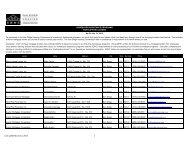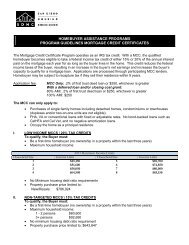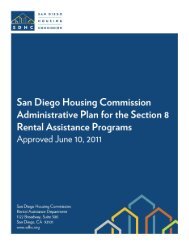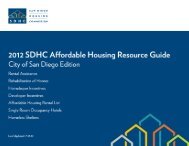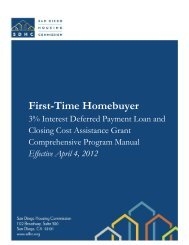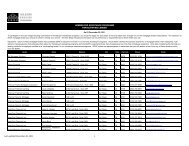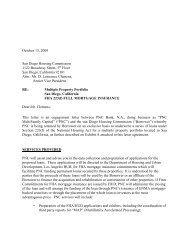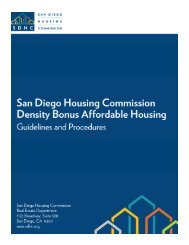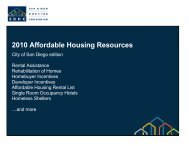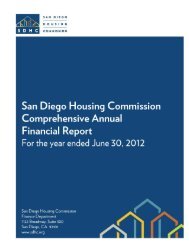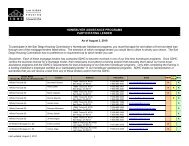Chapter 1 - San Diego Housing Commission
Chapter 1 - San Diego Housing Commission
Chapter 1 - San Diego Housing Commission
You also want an ePaper? Increase the reach of your titles
YUMPU automatically turns print PDFs into web optimized ePapers that Google loves.
<strong>Chapter</strong> 15 – Moving Forward:<br />
<strong>Housing</strong> Choice Voucher Homeownership Program<br />
financing approach. However, HUD encourages local public housing authorities to develop<br />
partnerships with lenders to better serve the needs of families. SDHC will counsel the family to<br />
avoid predatory lenders or lending practices. SDHC will review any financing package that arises<br />
from any lender approved by SDHC.<br />
4. Underwriting Options<br />
The following underwriting options are suggested under this program. The lender will decide upon<br />
the option based upon income and borrower qualifications determined on a case-by-case basis by<br />
the lender, and dependent upon the specific loan products utilized. However, because of the high<br />
cost market and other conditions, SDHC has determined the most feasible model for the program in<br />
the area is the Two Mortgage Approach and has established partners to be successful by using this<br />
model.<br />
- Option One: Deduct HAP from Principal, Interest, Taxes & Insurance (PITI)<br />
The borrower’s HAP is applied directly to the PITI, and the housing debt to income ratio is<br />
calculated on the “net housing obligation” of the borrower.<br />
- Option Two: Add HAP to Borrower’s Income<br />
Calculate total income as a combination of the tax-exempt HAP (grossed up by 25%) and the<br />
borrower’s income from employment using underwriting ratios specific to the loan product<br />
being used.<br />
- Option Three: Two-Mortgage Approach<br />
Borrower qualifies for the first mortgage (PITI) using the family’s income. The HAP is used to<br />
qualify the P&I for a second mortgage.<br />
5. Loan Restrictions<br />
Mortgages with negative amortization, interest-only, adjustable or variable interest rates are not<br />
allowed under this program. The buyer may not enter into private seller financing. Lease-purchase<br />
agreements will be explored on a case-by-case basis subject to changing conditions in the market.<br />
SDHC reserves the right to review lender qualifications and the loan terms before authorizing<br />
homeownership assistance. SDHC may disapprove proposed financing of the debt if SDHC<br />
determines that the debt is unaffordable. In making this determination, SDHC will take into account<br />
family expenses such as childcare, un-reimbursed medical expenses, homeownership expenses, and<br />
other family expenses, in addition to the participant’s income.<br />
On the initial purchase, SDHC has determined it will use an affordability cap that the family share<br />
can be no greater than 45% of their adjusted income. Family share will be the homeowner expenses<br />
less the HAP.<br />
SDHC must review and approve any proposed refinancing of the property and any requests to open<br />
home equity lines of credit.<br />
Refinancing the property, without prior written approval from SDHC, may result in termination of<br />
the HCV Homeownership assistance.<br />
In making its determination, SDHC will take into account the reason(s) for the request to refinance,<br />
as well as the current assets and liabilities of the family, and how the refinancing will affect the total<br />
tenant payment. Homeownership assistance may continue if refinancing is approved, but will be<br />
limited to the remaining term on the initial mortgage loan.<br />
15-12




